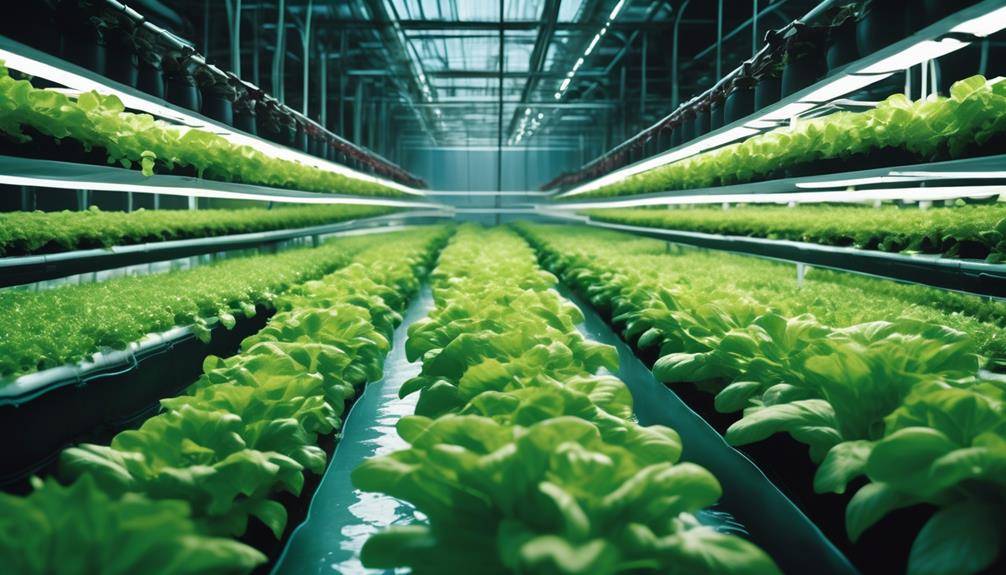How To: Improving Crop Yield With Hydroponics

Improving Crop Yield With Hydroponics; Imagine a world where every seed planted grows into a thriving, fruitful plant, yielding an abundance of crops. Well, with the use of hydroponics, that world is within reach. By utilizing this innovative farming method, you can significantly improve crop yield and overcome various challenges faced by traditional soil-based agriculture. But how exactly does hydroponics work? And what are the benefits it offers? In this discussion, we will explore the fascinating world of hydroponics, uncovering its potential to revolutionize modern farming practices and provide sustainable solutions to feeding our growing global population. Get ready to discover the secrets behind maximizing crop yield with hydroponics.
The Basics of Hydroponics
Hydroponics is a highly efficient method of cultivating crops that eliminates the need for soil and instead relies on a nutrient-rich solution to nourish plants directly. When it comes to hydroponics, nutrient solution management plays a crucial role in ensuring optimal plant growth and yield. The nutrient solution serves as the primary source of essential nutrients for the plants, and it is imperative to maintain the correct balance and composition.
Proper nutrient solution management involves monitoring and controlling the pH level. The pH level of the solution affects the availability and absorption of nutrients by the plants. Most hydroponic crops thrive in a slightly acidic pH range of 5.5 to 6.5. Maintaining the correct pH level is essential for preventing nutrient deficiencies or toxicities.
To control the pH level, various solutions can be used, such as pH adjusters or buffers. These substances help maintain the desired pH range by either increasing or decreasing the acidity of the nutrient solution. Regular monitoring of the pH level is crucial, as it can fluctuate due to factors like plant uptake, evaporation, or changes in the water source.
Aside from pH level control, nutrient solution management also involves monitoring the nutrient concentration. Nutrient solutions need to be replenished regularly to ensure that plants receive an adequate supply of essential elements. Testing the nutrient solution’s electrical conductivity (EC) can help determine its nutrient concentration and whether adjustments are necessary.
Types of Hydroponic Systems
Now let’s explore the different types of hydroponic systems available. Understanding the various system types is crucial for implementing an effective hydroponic setup. Each system offers unique benefits, such as increased control over nutrient delivery, improved oxygenation, and efficient use of space. By familiarizing yourself with these system types, you can make informed decisions to optimize crop yield and maximize the benefits of hydroponics.
System Types
There are several types of hydroponic systems that are commonly used to improve crop yield. One such system is vertical farming, which involves growing plants in vertically stacked layers. This method maximizes space utilization and allows for efficient water and nutrient distribution. Vertical farming systems often incorporate the use of artificial lighting to provide the necessary light energy for plant growth.
Another popular hydroponic system is the nutrient film technique (NFT). This system involves a thin film of nutrient-rich water flowing continuously over the plant roots. The roots absorb the necessary nutrients while being exposed to the air, promoting oxygenation. NFT systems are known for their efficiency in water usage and nutrient delivery. They are commonly used for growing leafy greens and herbs.
These types of hydroponic systems offer precise control over environmental conditions, allowing for optimal plant growth and higher crop yields. By implementing these systems, farmers can significantly increase their productivity and contribute to sustainable agriculture practices.
Benefits of Hydroponics
One of the key advantages of hydroponic systems is the ability to tailor specific types of systems based on the needs of different crops. This flexibility allows farmers to optimize growing conditions, leading to higher crop yields. Here are some benefits of hydroponics:
- Increased crop yield: Hydroponic systems provide an ideal growing environment with controlled nutrient levels, pH, and light exposure. This leads to faster growth and larger yields compared to traditional soil-based farming.
- Water efficiency: Hydroponics uses up to 90% less water compared to conventional farming methods. The recirculation of nutrient-rich water eliminates water waste and ensures that plants receive the exact amount of moisture they need.
- Reduced space requirements: Hydroponics allows for vertical farming, making it possible to grow crops in limited spaces. This is especially beneficial in urban environments or areas with scarce farmland.
- Disease and pest control: By eliminating soil, hydroponics reduces the risk of soil-borne diseases and pests. This minimizes the need for chemical pesticides, resulting in healthier produce.
While hydroponic farming offers numerous benefits, it also comes with its own set of challenges. Adequate knowledge and expertise are required to maintain the system and ensure optimal plant growth. Additionally, the initial setup cost can be higher compared to traditional farming methods. However, the long-term benefits and potential for increased crop yields make hydroponics a promising solution for sustainable agriculture.
Advantages of Hydroponic Farming
Hydroponic farming offers numerous advantages that can significantly improve crop yield. One of the key advantages is the potential for vertical farming. Vertical farming allows crops to be grown in stacked layers, maximizing the use of space and increasing the overall yield per unit area. This is particularly beneficial in urban areas where land availability is limited. By utilizing vertical space, hydroponic farms can produce a higher volume of crops compared to traditional soil-based farming methods.
Another advantage of hydroponic farming is its cost-effectiveness. Although the initial setup cost of a hydroponic system may be higher compared to traditional farming, the long-term benefits outweigh the initial investment. Hydroponic systems require less water compared to soil-based farming, resulting in lower water usage and reduced water costs. Additionally, the controlled environment of hydroponic systems allows for better pest and disease management, reducing the need for pesticides and herbicides. This not only saves money but also contributes to a healthier and more sustainable farming practice.
Furthermore, hydroponic farming offers better nutrient management. In a hydroponic system, nutrients are directly supplied to the plants’ roots, ensuring that they receive the optimal amount of nutrients for their growth. This precise control over nutrient delivery leads to faster growth rates and higher crop yields. Additionally, hydroponic farming allows for the recycling and reuse of nutrient solutions, further reducing costs and minimizing environmental impact.
Nutrient Management in Hydroponics
To optimize the growth and yield of crops in hydroponics, it is crucial to carefully manage the nutrient solution composition. The nutrient solution serves as the sole source of essential elements for plant growth, so its composition must be accurately balanced to meet the specific needs of each crop. Additionally, understanding and improving nutrient uptake efficiency is vital to ensure that plants can effectively absorb and utilize the provided nutrients for optimal growth and development.
Nutrient Solution Composition
Improving crop yield in hydroponics necessitates careful management of nutrient solution composition. The nutrient solution serves as the sole source of essential nutrients for the plants, making it crucial to ensure that it provides all the necessary elements in the right proportions. To achieve optimal nutrient solution composition, consider the following:
- Macronutrients: Nitrogen (N), phosphorus (P), and potassium (K) are essential for plant growth and development. Adjust their concentrations based on the specific crop requirements.
- Micronutrients: Iron (Fe), manganese (Mn), zinc (Zn), and other trace elements play a vital role in various metabolic processes. Monitor their levels to prevent nutrient deficiencies.
- pH balance: Maintaining the appropriate pH range (usually between 5.5 and 6.5) ensures nutrient availability and uptake.
- Electrical conductivity (EC): Measure the EC regularly to assess the nutrient concentration and adjust it as needed.
Nutrient Uptake Efficiency
Nutrient uptake efficiency in hydroponics is a critical aspect of nutrient management that must be carefully considered. With the growing popularity of vertical farming and the use of the nutrient film technique (NFT), it is essential to maximize the uptake of nutrients by plants to achieve optimal crop yield.
In hydroponics, the nutrient solution is directly supplied to the plant roots, bypassing the need for soil. This allows for precise control over the nutrient composition and availability. However, the efficiency of nutrient uptake depends on various factors, including the concentration and balance of nutrients in the solution, pH levels, and root health.
To improve nutrient uptake efficiency, it is crucial to monitor and adjust the nutrient solution regularly. This involves maintaining the appropriate nutrient levels, ensuring a balanced nutrient ratio, and optimizing pH levels to facilitate nutrient absorption. Additionally, maintaining healthy root systems through proper aeration and preventing root diseases can further enhance nutrient uptake efficiency.
Controlling Environmental Factors for Maximum Yield
Maximizing crop yield in hydroponics relies on the precise control of various environmental factors. By optimizing these factors, you can ensure that your plants receive the ideal conditions for growth and maximize nutrient absorption.
To control these environmental factors effectively, consider the following:
- Temperature: Maintain an optimal temperature range for your plants, typically between 65°F and 80°F (18°C and 27°C). Avoid extreme temperature fluctuations, as they can stress the plants and hinder their growth.
- Humidity: Maintain an appropriate level of humidity, typically between 50% and 70%, to prevent excessive moisture loss or fungal growth. This can be achieved through the use of ventilation systems or humidifiers.
- Light intensity: Provide adequate light for your plants by using artificial lighting systems, such as LED or fluorescent lights. Adjust the light intensity based on the specific requirements of each plant species, ensuring they receive the right amount of light for photosynthesis.
- pH and nutrient solution: Regularly monitor and adjust the pH level of the nutrient solution to maintain an optimal range for nutrient uptake. Most plants thrive in a pH range of 5.5 to 6.5. Additionally, ensure that the nutrient solution is properly balanced to provide all essential nutrients required for healthy plant growth.
Choosing the Right Crops for Hydroponics
To optimize hydroponic crop production, careful consideration must be given to selecting the most suitable crops for this cultivation method. Crop selection plays a crucial role in maximizing yields and ensuring a successful hydroponic system. When choosing crops for hydroponics, several factors need to be taken into account, including the plant’s growth habits, nutrient requirements, and adaptability to the hydroponic environment.
One important aspect to consider when selecting crops for hydroponics is their growth habits. It is essential to choose crops that have a compact and upright growth habit, as they are more suitable for vertical systems like NFT (Nutrient Film Technique) or aeroponics. Crops with sprawling growth habits may take up excessive space and could impede the growth of neighboring plants.
Another factor to consider is the nutrient requirements of the crops. Different plants have varying nutrient needs, and it is essential to select crops that can thrive with the available nutrient solution. Some crops, such as lettuce and herbs, have relatively low nutrient requirements, making them ideal choices for hydroponics. On the other hand, crops like tomatoes and peppers have higher nutrient demands and may require more precise nutrient management.
Adaptability to the hydroponic environment is also a crucial factor to consider when selecting crops. Some plants are naturally more adaptable to hydroponics, while others may struggle to adjust to this cultivation method. Crops like leafy greens, herbs, and strawberries are known for their adaptability to hydroponics and can achieve excellent yields in this system.
Enhancing Plant Growth With Artificial Lighting
To enhance plant growth in hydroponics systems, it is important to consider the light spectrum and intensity. Research has shown that different light spectra can have varying effects on plant growth and development. Additionally, the intensity of light plays a crucial role in determining plant yield. By optimizing both the spectrum and intensity of artificial lighting, hydroponic growers can maximize crop production and improve overall yield.
Light Spectrum and Growth
Enhancing plant growth with artificial lighting involves manipulating the light spectrum to optimize crop yield. By understanding the relationship between light wavelengths and photosynthesis, farmers and researchers can fine-tune the light spectrum to provide plants with the most beneficial light for growth. Here are some key considerations for light spectrum optimization:
- Red and blue light: These wavelengths are crucial for photosynthesis, as they are absorbed most efficiently by chlorophyll in plants.
- Green light: While not as efficient for photosynthesis, green light can penetrate deeper into the plant canopy, promoting overall plant growth.
- Far-red light: This wavelength can influence plant development, such as stem elongation and flowering, by interacting with phytochromes.
- White light: Combining different wavelengths, such as red, blue, and green, can provide a balanced spectrum that supports overall plant health and growth.
Light Intensity and Plant Yield
Light intensity plays a crucial role in enhancing plant growth with artificial lighting, directly impacting plant yield. As a hydroponic farmer, it is important to optimize light intensity to achieve maximum crop productivity. Light intensity optimization involves finding the ideal balance between providing sufficient light for photosynthesis while avoiding excessive light stress. By understanding the light requirements of different plant species, you can adjust the light intensity to meet their specific needs. Yield improvement techniques can also be employed to enhance plant growth.
For instance, adjusting the distance between the artificial light source and the plants can help regulate light intensity. Additionally, using reflective surfaces or light diffusers can distribute light evenly throughout the growing area, ensuring all plants receive adequate illumination. By implementing these light intensity optimization and yield improvement techniques, you can maximize crop yield in your hydroponic system.
Implementing Efficient Water Management Techniques
Implementing efficient water management techniques is essential for maximizing crop yield in hydroponic systems. Hydroponics is a soilless cultivation method that relies on nutrient-rich water to support plant growth. With careful management, you can optimize water usage and conserve this valuable resource. Here are some effective water management techniques for hydroponic systems:
- Recirculating water system: Utilize a recirculating system to minimize water wastage. By continuously reusing nutrient solution, you can significantly reduce water consumption.
- Monitoring and adjusting pH levels: Regularly monitor the pH levels of the nutrient solution. Maintaining the proper pH range ensures optimal nutrient uptake by the plants, reducing the need for excessive watering.
- Implementing drip irrigation: Drip irrigation delivers water and nutrients directly to the plant roots, minimizing water loss due to evaporation. This targeted approach ensures efficient water usage and prevents water from being wasted.
- Collecting and reusing runoff: Capture and reuse any runoff water from the hydroponic system. By collecting and treating this water, you can recycle it back into the system, further conserving water.
Preventing Pests and Disease in Hydroponics
To ensure the success of your hydroponic system, it is crucial to implement effective strategies for preventing pests and disease. Pest control and disease prevention are essential components of maintaining a healthy and productive hydroponic garden. Unlike traditional soil-based farming, hydroponic systems provide an optimal environment for pests and diseases to thrive. Therefore, it is important to take proactive measures to protect your crops.
One of the most effective methods of pest control in hydroponics is implementing strict hygiene practices. Maintaining a clean and sterilized environment can significantly reduce the risk of pest infestations. Regularly clean your hydroponic equipment, including reservoirs, grow trays, and irrigation lines, to prevent the buildup of algae, fungi, and other potential breeding grounds for pests. Additionally, using sterile media, such as rockwool or coco coir, can further minimize the risk of introducing pests into your system.
Another critical aspect of pest control is monitoring and early detection. Regularly inspect your plants for signs of pest activity, such as chewed leaves, wilting, or discoloration. Implementing sticky traps, placing them strategically throughout your hydroponic garden, can help catch flying insects before they have a chance to reproduce and cause damage.
In terms of disease prevention, maintaining a healthy nutrient solution is paramount. Ensure that the pH and nutrient levels are properly balanced to create an optimal growing environment for your plants. Imbalanced nutrient solutions can weaken your plants, making them more susceptible to diseases. Regularly monitor the nutrient solution and adjust as necessary.
Implementing a strict crop rotation schedule can also help prevent the spread of diseases. Avoid planting the same crop in the same location for consecutive growing cycles. This practice can help break the disease cycle and reduce the risk of infection.
Harvesting and Storing Hydroponic Crops
Harvesting and storing hydroponic crops requires careful attention to timing and proper handling techniques. To ensure the best quality and yield, it is important to follow specific harvesting techniques and implement effective post-harvest storage practices. Here are some key points to consider:
- Harvesting Techniques:
- Timing: Harvesting should be done at the optimal stage of maturity for each crop. This ensures maximum flavor, texture, and nutritional value.
- Cleanliness: Maintain a clean environment during harvesting to minimize the risk of contamination and spoilage. Use sanitized tools and gloves to handle the crops.
- Gentle Handling: Handle the harvested crops with care to avoid bruising or damage. This is particularly important for delicate crops such as lettuce or herbs.
- Efficient Harvesting: Implement efficient harvesting methods to minimize time between harvest and storage. This helps maintain the freshness and quality of the crops.
- Post Harvest Storage:
- Temperature and Humidity Control: Maintain the ideal temperature and humidity levels for each crop during storage. This slows down the ripening process and extends the shelf life.
- Packaging: Use suitable packaging materials to protect the crops from physical damage, moisture loss, and microbial contamination. Vacuum-sealed bags or airtight containers can be effective for certain crops.
- Quality Inspection: Regularly inspect the stored crops for any signs of spoilage or pests. Remove any damaged or rotten crops immediately to prevent the spread of decay.
- Inventory Management: Implement a system to track the inventory and rotation of stored crops. This ensures that older crops are used first, reducing waste and maintaining freshness.
Scaling Up Hydroponic Operations for Commercial Success
Scaling up hydroponic operations for commercial success requires careful planning, efficient resource management, and strategic decision-making. As hydroponics gains popularity as a sustainable and efficient method of crop production, it is crucial to address the scaling challenges and ensure the economic viability of large-scale hydroponic operations.
One of the key challenges in scaling up hydroponic operations is the need for significant investment in infrastructure and technology. To expand operations, you will need to invest in larger grow spaces, nutrient delivery systems, lighting, and climate control systems. These upfront costs can be substantial, but they are essential for achieving economies of scale and maximizing productivity.
Efficient resource management is another critical aspect of scaling up hydroponic operations. As you increase the size of your operation, you will need to carefully manage resources such as water, nutrients, and energy. Implementing advanced automation and monitoring systems can help optimize resource usage and minimize waste. Additionally, developing effective nutrient management strategies and recycling systems can contribute to the economic viability of your hydroponic operation.
Strategic decision-making plays a crucial role in scaling up hydroponic operations. As you expand, you will need to assess market demand and identify profitable crop varieties to grow. Conducting market research and establishing partnerships with distributors and retailers can help ensure a steady market for your produce. Additionally, consider diversifying your product range to cater to different consumer preferences and increase sales potential.
Case Studies: Successful Crop Yields With Hydroponics
Several case studies have demonstrated the successful crop yields that can be achieved through hydroponics. These studies provide valuable insights into the effectiveness of hydroponic techniques in improving crop production. Here are some noteworthy case studies showcasing the success of hydroponics:
- Study 1: Tomato Production: A study conducted by researchers at a renowned agricultural university compared the yield of tomatoes grown in soil with those grown hydroponically. The hydroponic tomatoes demonstrated a significantly higher yield, with larger and healthier fruits. This case study highlighted the potential of hydroponics in maximizing tomato production.
- Study 2: Leafy Greens: Another study focused on the cultivation of leafy greens, such as lettuce and spinach, using hydroponics. The researchers found that hydroponically grown greens exhibited faster growth rates and higher nutrient content compared to traditional soil-based cultivation. This case study emphasized the suitability of hydroponics for growing nutrient-rich leafy vegetables.
- Study 3: Strawberries: Hydroponic strawberry production was examined in a study conducted by a team of horticulturists. The results showed that hydroponic strawberries had a higher yield per square meter and were less susceptible to diseases and pests. The study demonstrated the potential of hydroponics in optimizing strawberry cultivation.
- Study 4: Vertical Farming: A case study on vertical farming using hydroponics showcased its ability to maximize crop yield in limited spaces. By utilizing vertical growing systems, farmers were able to cultivate a wide variety of crops, including herbs, microgreens, and even small fruits. This study highlighted the versatility of hydroponics in vertical farming scenarios.
These successful case studies provide compelling evidence of the benefits of hydroponics in achieving higher crop yields. By utilizing hydroponic techniques, farmers can optimize resource utilization, minimize environmental impact, and maximize productivity. These findings contribute to the growing body of research supporting the adoption of hydroponics as a sustainable and efficient method for crop production.
Improving Crop Yield With Hydroponics; Frequently Asked Questions
How Much Does It Cost to Set up a Hydroponic System?
Setting up a hydroponic system can be costly, but a cost analysis reveals potential benefits. By eliminating the need for soil and optimizing nutrient delivery, hydroponics improves crop yield and allows for year-round cultivation.
Can Hydroponic Farming Be Done in Small Spaces, Like Apartments or Balconies?
Yes, hydroponic farming can be done in small spaces like apartments or balconies. Apartment hydroponics and balcony farming offer opportunities to grow crops using water-based systems and nutrient solutions, maximizing limited space for higher crop yield.
Is Hydroponic Farming More Sustainable Than Traditional Farming Methods?
Hydroponic farming is more sustainable than traditional farming methods due to its reduced environmental impact. With hydroponics, resources like water, space, and nutrients are used more efficiently, resulting in higher crop yields and less waste.
Can Hydroponics Be Used to Grow All Types of Crops?
Hydroponics offers advantages for growing various crops, such as increased yield and reduced water usage. However, it also has disadvantages, like high initial costs and complex nutrient management. Overall, hydroponics can be used to grow many types of crops effectively.
What Are the Potential Risks and Challenges of Implementing Hydroponics on a Large Scale?
When implementing hydroponics on a large scale, you may encounter potential risks and scalability challenges. These include the need for precise nutrient management, increased costs for infrastructure and equipment, and the potential for system failures.
Conclusion
In conclusion, hydroponics proves to be a highly efficient and effective method for improving crop yield. With its various types of systems, precise nutrient management, and control over environmental factors, hydroponics provides optimal conditions for plant growth. Additionally, the ability to prevent pests and diseases and scale up operations makes it a viable choice for commercial success. Through case studies, it is evident that hydroponics consistently delivers successful crop yields, making it a promising solution for sustainable agriculture.








